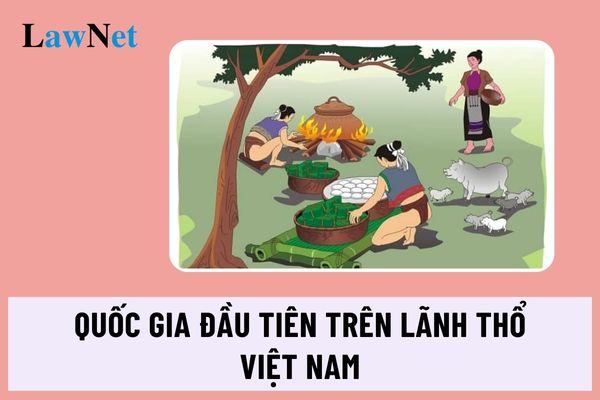Which were the first states on the territory of Vietnam?
In which grade do students learn about the first states on the territory of Vietnam?
Based on section 1.1, sub-section 1, Section 5 of the General Education Program for History and Geography issued with Circular 32/2018/TT-BGDDT, it is stipulated as follows:
| Content Line | Grade 4 | Grade 5 | |
| Introduction | Getting acquainted with History and Geography learning tools | x | |
| Local and regional geography of Vietnam | Your locality (province, centrally governed city) | x | |
| Midland and Northern Mountains | x | ||
| Red River Delta | x | ||
| Central Coastal | x | ||
| Central Highlands | x | ||
| Southern Region | x | ||
| Vietnam | The country and people of Vietnam | x | |
| The first states on the territory of Vietnam | x | ||
| Building and defending the Vietnam state | x | ||
| World | Neighboring countries | x | |
| Exploring the world | x | ||
| Joining hands in building the world | x |
Grade 5 students will learn about the first states on the territory of Vietnam.

What are the first states on the territory of Vietnam? (Image from the Internet)
What are the first states on the territory of Vietnam?
According to Section 5 of the General Education Program for History and Geography issued with Circular 32/2018/TT-BGDDT, the first states on the territory of Vietnam include: Van Lang, Au Lac; Phu Nam; Champa.
For the lesson on the first states on the territory of Vietnam, Grade 5 students need to achieve the following requirements:
| Knowledge Content | Required Achievements |
| Van Lang, Au Lac | - Describe the establishment of Van Lang, Au Lac through understanding some legends and archaeological evidence. - Using historical knowledge and some historical legends (Son Tinh - Thuy Tinh, Thanh Giong, The Legend of the Magic Crossbow...), describe the economic life and the struggle to protect the state of Van Lang, Au Lac. |
| Phu Nam | - Describe the establishment of Phu Nam through the state's founding legend and some archaeological evidence. - Describe some archaeological artifacts of Phu Nam. |
| Champa | - Name and locate on a map or diagram some remaining Champa temples and towers. - Collect some materials (photos, historical stories, ...) to describe a Champa temple. - Research and recount some stories about Champa temples. |
How did the state of Van Lang and Au Lac come into existence?
The emergence of the state of Van Lang, Au Lac through understanding some legends and archaeological evidence:
(1) The establishment of the state of Van Lang:
- Around the 7th century BC, due to the development of bronze and iron tools, the production life of ancient Vietnamese people had significant changes.
- The need for communal living, joint irrigation work, and defense against invaders promoted the establishment of the first state in Vietnam - The state of Van Lang.
The significance of the establishment of the state of Van Lang: It marked the beginning of the stateal founding era in the history of the state.
Additionally, the head of the state of Van Lang was Hung Vuong and the civil servants in the court were the civil leaders (also known as Lac Hau), military leaders (also known as Lac Tuong) who governed local regions and minor officials known as Bo Chinh.
According to the genealogy of Hung Vuong, there were 18 generations of Hung kings, including:
- Kinh Duong Vuong
- Lac Long Quan
- Hung Quoc Vuong
- Hung Hoa Vuong
- Hung Hy Vuong
- Hung Hon Vuong
- Hung Chieu Vuong
- Hung Vy Vuong
- Hung Dinh Vuong
- Hung Uy Vuong
- Hung Trinh Vuong
- Hung Vu Vuong
- Hung Viet Vuong
- Hung Anh Vuong
- Hung Trieu Vuong
- Hung Tao Vuong
- Hung Nghi Vuong
- Hung Due Vuong
(2) The establishment of the state of Au Lac:
- At the end of the 3rd century BC, the Qin dynasty sent troops to invade the south.
The Lac Viet and Au Viet people united to resist the invaders.
They appointed a "talented person" named Thuc Phan to lead the resistance. Thuc Phan became king, calling himself An Duong Vuong, establishing the state of Au Lac (in 208 BC).
- The state of Au Lac expanded its territory and had a more complete organization compared to the state of Van Lang.
According to archaeological evidence, An Duong Vuong built a fairly strong army proficient in the use of bows and arrows. The various weapons, along with over ten thousand arrowheads excavated from the Co Loa citadel, testify to this. Au Lac also had a navy that trained regularly.
- After the establishment of the state of Au Lac, An Duong Vuong chose Co Loa (Dong Anh, Hanoi) as the capital.
(3) Economic life:
The residents of Van Lang, Au Lac knew how to cultivate wet rice and various vegetables and tubers, and they also engaged in livestock raising and fishing. Moreover, they had various crafts such as pottery, carpentry, weaving, bronze casting, and iron-working...
(4) Struggle efforts:
Through legends like Thanh Giong, The Legend of the Magic Crossbow..., it can be seen that from the Van Lang, Au Lac era, the Vietnamese people conducted resistance wars to protect the state.
These wars demonstrated the spirit of patriotism and the process of resisting foreign invaders by the Vietnamese people from ancient times.
Note: the above content is for reference purposes only.

